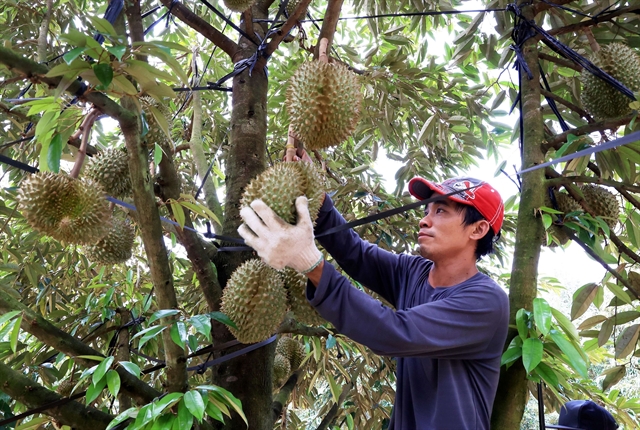 Economy
Economy


|
| Viêt Nam exports many kinds of fruit to China, including bananas, jackfruit, mangos, longans, dragon fruits and durians. —Photo dangcongsan.vn |
HÀ NỘI — The Ministry of Agriculture and Rural Development (MARD) will halt the use of planting area codes and the operations of packaging facilities that fail to meet China’s phytosanitary requirements.
The suspension is also applied for the batches which repeated violations many times during the phytosanitary inspections.
That is part of a dispatch sent by MARD to localities asking them to enhance phytosanitary measures for fruit exports, according to the ministry.
Before that, the General Administration of Customs of China (GACC) has had announcement that some fruit shipments exported from Việt Nam to China has not met phytosanitary requirements, including bananas, jackfruit, mango, longan, dragon fruit and durian.
Loose examination of the quality of fruits and ineffective phytosanitary operations can lead to an increase in the number of consignments violating China's phytosanitary regulations, said the ministry. That could lead to Việt Nam losing this important export market.
The MARD also urged the localities to strengthen manpower for phytosanitary operations at packaging facilities and planting areas granted codes by China's relevant offices to avoid China’s suspension of buying Vietnamese fruits.
The localities should publicise China’s requirements on plant quarantine and MARD’s guidelines on food safety for farmers, farming households and exporters.
Besides closer supervision of phytosanitary processes, the localities' departments of agriculture and rural development ask the packaging facilities to sanitise batches of fruits and have careful checks for the packaging process.
The ministry has also asked localities having border gates to promote plant quarantine work to ensure fruits meet China’s requirements.
The Ministry said Việt Nam gained US$1 billion from the exports of vegetables and fruits in June, up 2.7 times compared to June 2022. In the first six months of this year, the total fruit and vegetable export turnover was estimated at $3 billion - near the $3.16 billion of the whole year of 2022.
Among the top ten largest fruit and vegetable export markets of Việt Nam, China led with nearly 63.5 per cent of the market share, worth about $1.3 billion in the first five months of the year. Following were South Korea, Japan and the Netherlands.
According to businesses, the Phytosanitary Protocols signed with China, along with codes for thousands of planting areas and packaging facilities granted by China authorities, have created many favourable conditions for Việt Nam in exporting vegetables and fruits to this neighbouring market. — VNS




